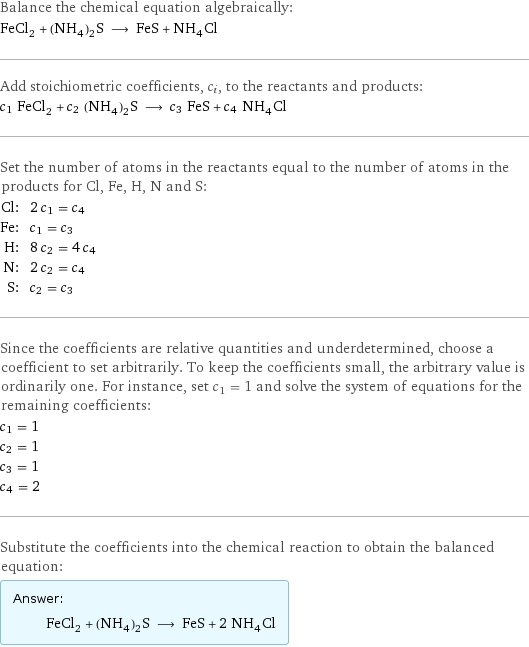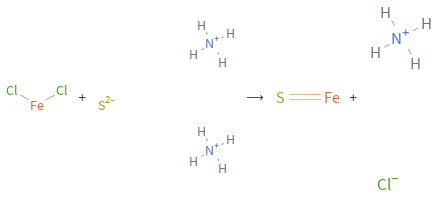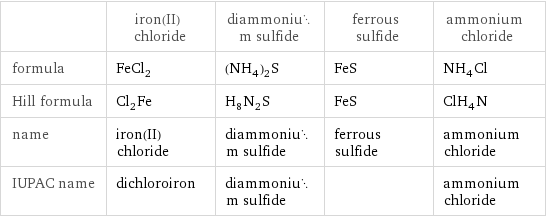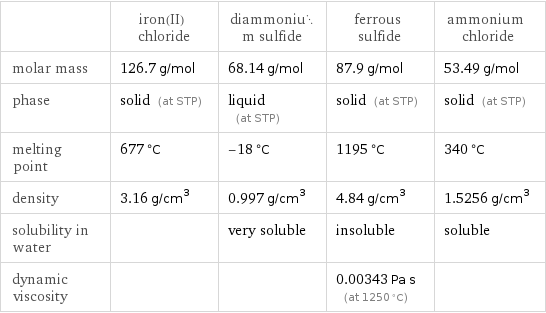Input interpretation

FeCl_2 iron(II) chloride + (NH_4)_2S diammonium sulfide ⟶ FeS ferrous sulfide + NH_4Cl ammonium chloride
Balanced equation

Balance the chemical equation algebraically: FeCl_2 + (NH_4)_2S ⟶ FeS + NH_4Cl Add stoichiometric coefficients, c_i, to the reactants and products: c_1 FeCl_2 + c_2 (NH_4)_2S ⟶ c_3 FeS + c_4 NH_4Cl Set the number of atoms in the reactants equal to the number of atoms in the products for Cl, Fe, H, N and S: Cl: | 2 c_1 = c_4 Fe: | c_1 = c_3 H: | 8 c_2 = 4 c_4 N: | 2 c_2 = c_4 S: | c_2 = c_3 Since the coefficients are relative quantities and underdetermined, choose a coefficient to set arbitrarily. To keep the coefficients small, the arbitrary value is ordinarily one. For instance, set c_1 = 1 and solve the system of equations for the remaining coefficients: c_1 = 1 c_2 = 1 c_3 = 1 c_4 = 2 Substitute the coefficients into the chemical reaction to obtain the balanced equation: Answer: | | FeCl_2 + (NH_4)_2S ⟶ FeS + 2 NH_4Cl
Structures

+ ⟶ +
Names

iron(II) chloride + diammonium sulfide ⟶ ferrous sulfide + ammonium chloride
Equilibrium constant
![Construct the equilibrium constant, K, expression for: FeCl_2 + (NH_4)_2S ⟶ FeS + NH_4Cl Plan: • Balance the chemical equation. • Determine the stoichiometric numbers. • Assemble the activity expression for each chemical species. • Use the activity expressions to build the equilibrium constant expression. Write the balanced chemical equation: FeCl_2 + (NH_4)_2S ⟶ FeS + 2 NH_4Cl Assign stoichiometric numbers, ν_i, using the stoichiometric coefficients, c_i, from the balanced chemical equation in the following manner: ν_i = -c_i for reactants and ν_i = c_i for products: chemical species | c_i | ν_i FeCl_2 | 1 | -1 (NH_4)_2S | 1 | -1 FeS | 1 | 1 NH_4Cl | 2 | 2 Assemble the activity expressions accounting for the state of matter and ν_i: chemical species | c_i | ν_i | activity expression FeCl_2 | 1 | -1 | ([FeCl2])^(-1) (NH_4)_2S | 1 | -1 | ([(NH4)2S])^(-1) FeS | 1 | 1 | [FeS] NH_4Cl | 2 | 2 | ([NH4Cl])^2 The equilibrium constant symbol in the concentration basis is: K_c Mulitply the activity expressions to arrive at the K_c expression: Answer: | | K_c = ([FeCl2])^(-1) ([(NH4)2S])^(-1) [FeS] ([NH4Cl])^2 = ([FeS] ([NH4Cl])^2)/([FeCl2] [(NH4)2S])](../image_source/d242a7e3f27e92457aff738df1aab02d.png)
Construct the equilibrium constant, K, expression for: FeCl_2 + (NH_4)_2S ⟶ FeS + NH_4Cl Plan: • Balance the chemical equation. • Determine the stoichiometric numbers. • Assemble the activity expression for each chemical species. • Use the activity expressions to build the equilibrium constant expression. Write the balanced chemical equation: FeCl_2 + (NH_4)_2S ⟶ FeS + 2 NH_4Cl Assign stoichiometric numbers, ν_i, using the stoichiometric coefficients, c_i, from the balanced chemical equation in the following manner: ν_i = -c_i for reactants and ν_i = c_i for products: chemical species | c_i | ν_i FeCl_2 | 1 | -1 (NH_4)_2S | 1 | -1 FeS | 1 | 1 NH_4Cl | 2 | 2 Assemble the activity expressions accounting for the state of matter and ν_i: chemical species | c_i | ν_i | activity expression FeCl_2 | 1 | -1 | ([FeCl2])^(-1) (NH_4)_2S | 1 | -1 | ([(NH4)2S])^(-1) FeS | 1 | 1 | [FeS] NH_4Cl | 2 | 2 | ([NH4Cl])^2 The equilibrium constant symbol in the concentration basis is: K_c Mulitply the activity expressions to arrive at the K_c expression: Answer: | | K_c = ([FeCl2])^(-1) ([(NH4)2S])^(-1) [FeS] ([NH4Cl])^2 = ([FeS] ([NH4Cl])^2)/([FeCl2] [(NH4)2S])
Rate of reaction
![Construct the rate of reaction expression for: FeCl_2 + (NH_4)_2S ⟶ FeS + NH_4Cl Plan: • Balance the chemical equation. • Determine the stoichiometric numbers. • Assemble the rate term for each chemical species. • Write the rate of reaction expression. Write the balanced chemical equation: FeCl_2 + (NH_4)_2S ⟶ FeS + 2 NH_4Cl Assign stoichiometric numbers, ν_i, using the stoichiometric coefficients, c_i, from the balanced chemical equation in the following manner: ν_i = -c_i for reactants and ν_i = c_i for products: chemical species | c_i | ν_i FeCl_2 | 1 | -1 (NH_4)_2S | 1 | -1 FeS | 1 | 1 NH_4Cl | 2 | 2 The rate term for each chemical species, B_i, is 1/ν_i(Δ[B_i])/(Δt) where [B_i] is the amount concentration and t is time: chemical species | c_i | ν_i | rate term FeCl_2 | 1 | -1 | -(Δ[FeCl2])/(Δt) (NH_4)_2S | 1 | -1 | -(Δ[(NH4)2S])/(Δt) FeS | 1 | 1 | (Δ[FeS])/(Δt) NH_4Cl | 2 | 2 | 1/2 (Δ[NH4Cl])/(Δt) (for infinitesimal rate of change, replace Δ with d) Set the rate terms equal to each other to arrive at the rate expression: Answer: | | rate = -(Δ[FeCl2])/(Δt) = -(Δ[(NH4)2S])/(Δt) = (Δ[FeS])/(Δt) = 1/2 (Δ[NH4Cl])/(Δt) (assuming constant volume and no accumulation of intermediates or side products)](../image_source/7407d4954af0cfb5deb22491fe60ecd5.png)
Construct the rate of reaction expression for: FeCl_2 + (NH_4)_2S ⟶ FeS + NH_4Cl Plan: • Balance the chemical equation. • Determine the stoichiometric numbers. • Assemble the rate term for each chemical species. • Write the rate of reaction expression. Write the balanced chemical equation: FeCl_2 + (NH_4)_2S ⟶ FeS + 2 NH_4Cl Assign stoichiometric numbers, ν_i, using the stoichiometric coefficients, c_i, from the balanced chemical equation in the following manner: ν_i = -c_i for reactants and ν_i = c_i for products: chemical species | c_i | ν_i FeCl_2 | 1 | -1 (NH_4)_2S | 1 | -1 FeS | 1 | 1 NH_4Cl | 2 | 2 The rate term for each chemical species, B_i, is 1/ν_i(Δ[B_i])/(Δt) where [B_i] is the amount concentration and t is time: chemical species | c_i | ν_i | rate term FeCl_2 | 1 | -1 | -(Δ[FeCl2])/(Δt) (NH_4)_2S | 1 | -1 | -(Δ[(NH4)2S])/(Δt) FeS | 1 | 1 | (Δ[FeS])/(Δt) NH_4Cl | 2 | 2 | 1/2 (Δ[NH4Cl])/(Δt) (for infinitesimal rate of change, replace Δ with d) Set the rate terms equal to each other to arrive at the rate expression: Answer: | | rate = -(Δ[FeCl2])/(Δt) = -(Δ[(NH4)2S])/(Δt) = (Δ[FeS])/(Δt) = 1/2 (Δ[NH4Cl])/(Δt) (assuming constant volume and no accumulation of intermediates or side products)
Chemical names and formulas

| iron(II) chloride | diammonium sulfide | ferrous sulfide | ammonium chloride formula | FeCl_2 | (NH_4)_2S | FeS | NH_4Cl Hill formula | Cl_2Fe | H_8N_2S | FeS | ClH_4N name | iron(II) chloride | diammonium sulfide | ferrous sulfide | ammonium chloride IUPAC name | dichloroiron | diammonium sulfide | | ammonium chloride
Substance properties

| iron(II) chloride | diammonium sulfide | ferrous sulfide | ammonium chloride molar mass | 126.7 g/mol | 68.14 g/mol | 87.9 g/mol | 53.49 g/mol phase | solid (at STP) | liquid (at STP) | solid (at STP) | solid (at STP) melting point | 677 °C | -18 °C | 1195 °C | 340 °C density | 3.16 g/cm^3 | 0.997 g/cm^3 | 4.84 g/cm^3 | 1.5256 g/cm^3 solubility in water | | very soluble | insoluble | soluble dynamic viscosity | | | 0.00343 Pa s (at 1250 °C) |
Units
